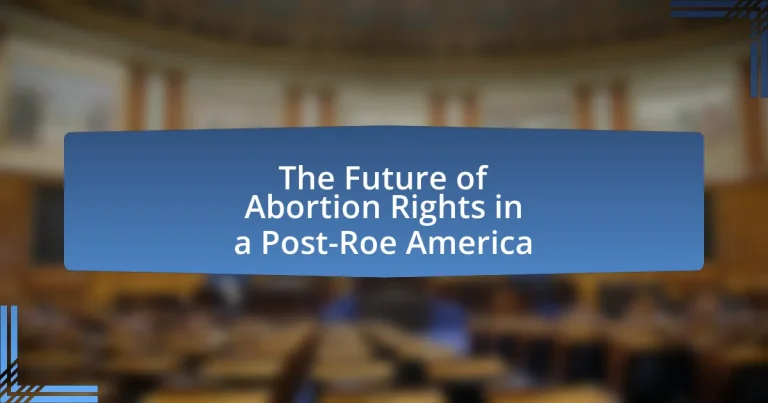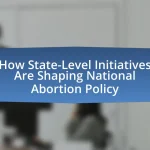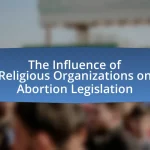The article examines the future of abortion rights in the United States following the Supreme Court’s decision to overturn Roe v. Wade. It highlights the significant implications of this ruling, including the decentralization of abortion access, the emergence of restrictive laws in various states, and the resulting disparities in reproductive healthcare. Key topics include the changing legal landscape, the societal and economic impacts of restricted access, the role of political parties, and the ongoing advocacy efforts by grassroots organizations. The article also explores potential future scenarios for abortion rights, emphasizing the influence of state legislation, federal actions, and public opinion on the evolving landscape of reproductive rights.
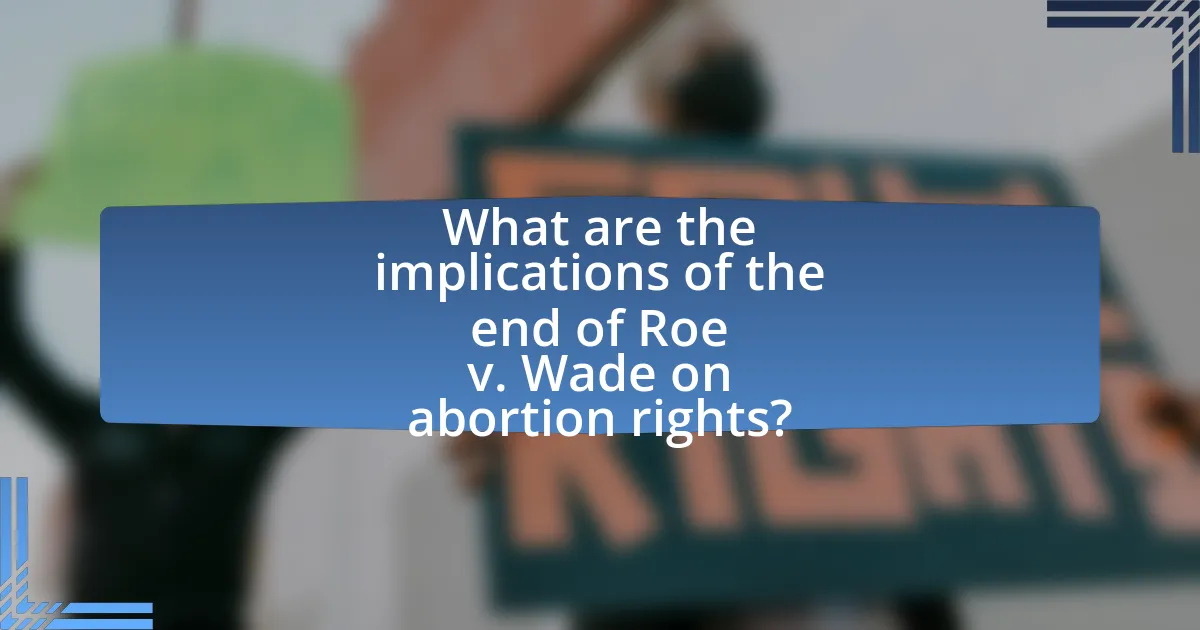
What are the implications of the end of Roe v. Wade on abortion rights?
The end of Roe v. Wade has significant implications for abortion rights, primarily leading to the decentralization of abortion access across the United States. Following the Supreme Court’s decision to overturn Roe v. Wade, many states have enacted laws that either severely restrict or completely ban abortions, resulting in a patchwork of abortion rights that varies widely by state. For instance, as of 2023, over 20 states have implemented bans or strict limitations on abortion, while others maintain protections for the procedure. This shift has created disparities in access to reproductive healthcare, disproportionately affecting low-income individuals and those in rural areas who may have to travel long distances to obtain services. The implications also extend to legal battles, as states with restrictive laws face challenges that could further shape the landscape of abortion rights in the future.
How has the legal landscape changed for abortion rights in America?
The legal landscape for abortion rights in America has significantly changed following the Supreme Court’s decision in Dobbs v. Jackson Women’s Health Organization in June 2022, which overturned Roe v. Wade. This ruling eliminated the federal constitutional right to abortion, allowing individual states to set their own abortion laws. As a result, many states enacted restrictive laws or outright bans, while others moved to protect abortion rights. For instance, states like Texas and Alabama implemented stringent regulations, whereas states like California and New York expanded access to abortion services. This shift has led to a patchwork of laws across the country, creating disparities in access to abortion based on geographic location.
What states have enacted stricter abortion laws since Roe was overturned?
Since Roe v. Wade was overturned in June 2022, several states have enacted stricter abortion laws. States such as Texas, Alabama, Arkansas, and Oklahoma have implemented significant restrictions, including near-total bans or severe limitations on abortion access. For instance, Texas passed a law prohibiting abortions after six weeks of pregnancy, while Alabama enacted a law that criminalizes nearly all abortions, with no exceptions for rape or incest. These legislative changes reflect a broader trend among conservative states to restrict abortion rights following the Supreme Court’s decision.
How do these changes affect access to abortion services nationwide?
Changes in abortion laws and regulations significantly restrict access to abortion services nationwide. Following the Supreme Court’s decision to overturn Roe v. Wade, many states enacted laws that either severely limit or outright ban abortions, leading to a patchwork of access across the country. For instance, a report from the Guttmacher Institute indicates that as of 2023, over 20 states have implemented bans or severe restrictions, resulting in increased travel distances for individuals seeking abortions and heightened disparities in access based on geographic and socioeconomic factors. This legal landscape creates barriers that disproportionately affect marginalized communities, limiting their reproductive healthcare options.
What are the potential societal impacts of restricted abortion access?
Restricted abortion access can lead to significant societal impacts, including increased rates of unintended pregnancies and maternal mortality. Studies indicate that when abortion is restricted, women may resort to unsafe methods, leading to higher health risks; for instance, the World Health Organization reports that unsafe abortions contribute to approximately 47,000 deaths annually worldwide. Additionally, restricted access can exacerbate socioeconomic disparities, as marginalized groups often face greater barriers to reproductive healthcare, resulting in increased poverty and reduced educational opportunities for women. Furthermore, the psychological effects of carrying an unwanted pregnancy can lead to long-term mental health issues, affecting family dynamics and community well-being.
How might restricted access to abortion affect women’s health outcomes?
Restricted access to abortion negatively affects women’s health outcomes by increasing the risk of unsafe procedures and adverse physical and mental health consequences. Studies indicate that when abortion is restricted, women may resort to unsafe methods, leading to complications such as infection, hemorrhage, and even death. For instance, the World Health Organization reports that unsafe abortions contribute to approximately 47,000 deaths annually worldwide. Furthermore, restricted access can exacerbate mental health issues, as women may experience increased anxiety, depression, and stress related to unwanted pregnancies. Research published in the American Journal of Public Health shows that women denied abortions are more likely to experience long-term mental health problems compared to those who receive the procedure.
What are the economic implications of limited abortion rights for families?
Limited abortion rights have significant economic implications for families, primarily by increasing financial strain and limiting economic mobility. Families facing unintended pregnancies may incur additional costs related to childcare, healthcare, and education, which can lead to increased poverty rates. For instance, research from the Turnaway Study indicates that women denied abortions are more likely to experience economic hardship, with 74% living below the federal poverty line within four years. Furthermore, limited access to abortion can hinder women’s participation in the workforce, reducing their earning potential and overall economic stability. This creates a cycle of disadvantage that affects not only the immediate family but also future generations, as children born into economically strained environments often face barriers to education and employment opportunities.
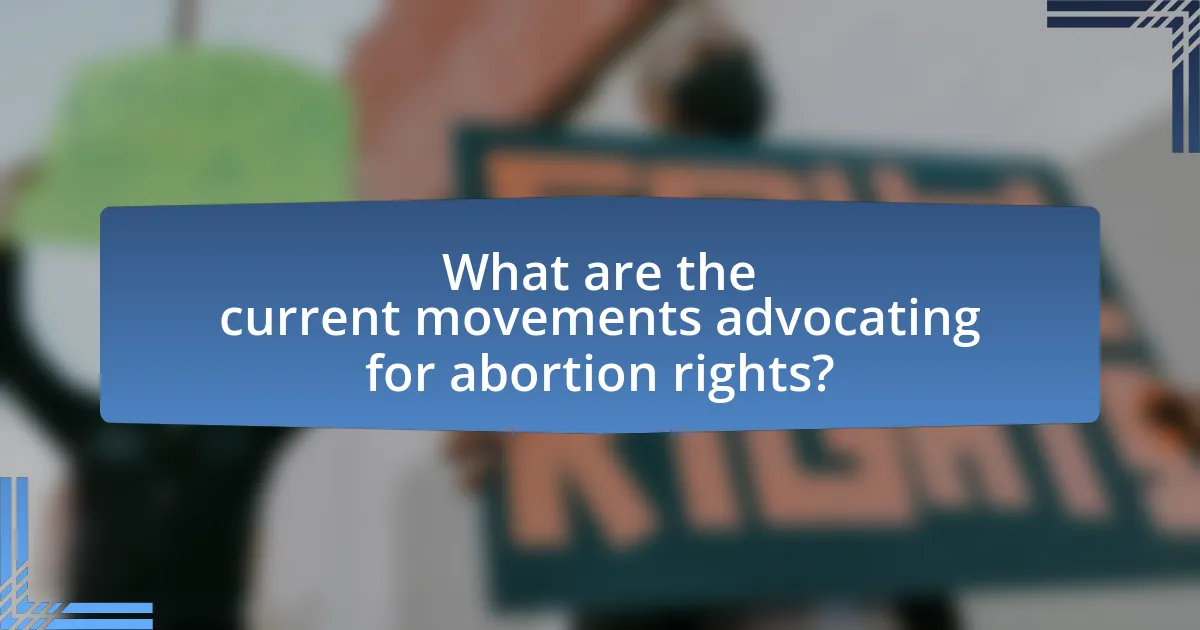
What are the current movements advocating for abortion rights?
Current movements advocating for abortion rights include organizations such as Planned Parenthood, the National Abortion Federation, and the Women’s March. These groups actively campaign for reproductive rights, provide education on abortion access, and mobilize grassroots efforts to influence legislation. For instance, Planned Parenthood has been instrumental in providing healthcare services and advocating for policy changes that protect abortion access, especially following the Supreme Court’s decision to overturn Roe v. Wade in 2022. The Women’s March has organized nationwide protests to raise awareness and demand legislative action to safeguard reproductive rights. These movements are crucial in the ongoing struggle for abortion rights in the United States.
How are grassroots organizations responding to the post-Roe landscape?
Grassroots organizations are mobilizing to provide support and resources for individuals seeking reproductive healthcare in the post-Roe landscape. These organizations are establishing networks to facilitate access to abortion services, including funding for travel and accommodations for those in states with restrictive laws. For instance, the National Network of Abortion Funds reported a significant increase in requests for assistance, highlighting the urgent need for financial support and logistical help for individuals facing barriers to care. Additionally, grassroots groups are engaging in advocacy efforts to influence local and state policies, aiming to protect and expand reproductive rights despite the challenges posed by recent legal changes.
What strategies are being employed to mobilize support for abortion rights?
Strategies employed to mobilize support for abortion rights include grassroots organizing, digital advocacy, and coalition-building among various social justice movements. Grassroots organizing involves local groups conducting outreach, hosting events, and engaging communities to raise awareness about reproductive rights. Digital advocacy utilizes social media platforms to disseminate information, mobilize supporters, and amplify voices of those affected by restrictive abortion laws. Coalition-building brings together diverse organizations, such as women’s rights groups, LGBTQ+ advocates, and healthcare providers, to create a unified front that emphasizes the intersectionality of reproductive rights. These strategies are supported by data indicating that states with strong grassroots movements have seen increased public support for abortion rights, as evidenced by polling data from organizations like the Guttmacher Institute.
How are these organizations addressing the needs of marginalized communities?
Organizations are addressing the needs of marginalized communities by providing targeted reproductive health services, education, and advocacy. For instance, many organizations focus on increasing access to abortion services for low-income individuals and people of color, who often face systemic barriers. According to the Guttmacher Institute, marginalized groups are disproportionately affected by restrictive abortion laws, making it essential for organizations to offer financial assistance, transportation services, and culturally competent care. Additionally, these organizations engage in policy advocacy to challenge discriminatory laws and promote equitable access to reproductive healthcare, ensuring that the voices of marginalized communities are represented in legislative discussions.
What role do political parties play in shaping abortion rights?
Political parties play a crucial role in shaping abortion rights through their platforms, legislative actions, and influence on public opinion. The Democratic Party generally supports abortion rights, advocating for access to safe and legal abortion services, while the Republican Party often opposes abortion, promoting restrictions and legislation aimed at limiting access. This ideological divide influences state and federal policies, as seen in the aftermath of the Supreme Court’s decision in Dobbs v. Jackson Women’s Health Organization, which overturned Roe v. Wade. Following this ruling, several Republican-led states enacted laws to restrict abortion access, while Democratic-led states moved to protect and expand abortion rights. The actions and policies of these parties directly impact the legal landscape surrounding abortion, reflecting their core values and the interests of their constituents.
How have party platforms shifted regarding abortion since the Roe decision?
Since the Roe v. Wade decision in 1973, party platforms regarding abortion have significantly shifted, particularly in the Republican and Democratic parties. The Republican Party has increasingly adopted a more restrictive stance, advocating for the overturning of Roe and supporting state-level bans on abortion, reflecting a growing alignment with anti-abortion advocacy groups. In contrast, the Democratic Party has moved towards a more supportive position on abortion rights, emphasizing access to reproductive healthcare and advocating for the codification of Roe into federal law, especially following the Supreme Court’s 2022 decision to overturn Roe v. Wade. This shift is evidenced by the Democratic platform’s explicit commitment to protecting reproductive rights, contrasting with the Republican platform’s calls for restrictions.
What influence do elections have on the future of abortion legislation?
Elections significantly influence the future of abortion legislation by determining the composition of legislative bodies and the executive branch, which directly impacts policy decisions. For instance, the 2020 elections resulted in a Democratic majority in the U.S. House of Representatives, leading to the introduction of pro-choice legislation, while Republican-controlled states have enacted restrictive abortion laws. Historical data shows that shifts in political power often correlate with changes in abortion access; for example, after the 2016 elections, several states passed laws limiting abortion rights, reflecting the priorities of the elected officials. Thus, the outcomes of elections shape the legal landscape surrounding abortion, affecting both access and rights.
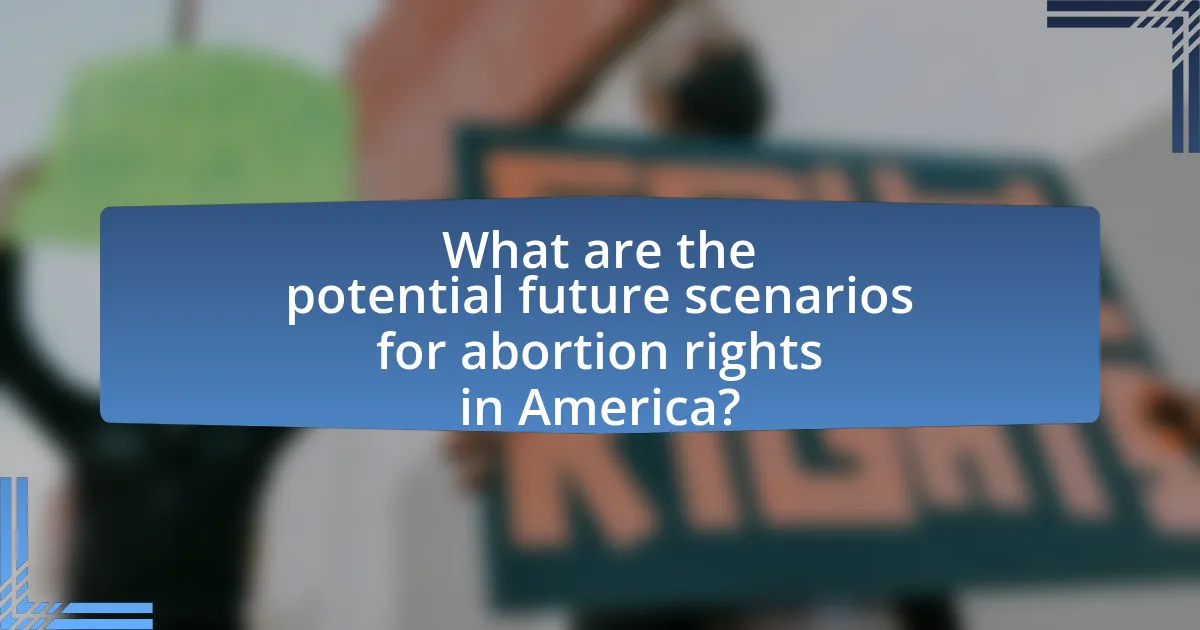
What are the potential future scenarios for abortion rights in America?
The potential future scenarios for abortion rights in America include a range of outcomes influenced by state legislation, federal actions, and public opinion. Following the Supreme Court’s decision to overturn Roe v. Wade in 2022, many states enacted restrictive laws, leading to a patchwork of access across the country. Some states may continue to tighten restrictions, while others could expand access through legislative measures or ballot initiatives. Additionally, federal legislation could emerge, either protecting abortion rights nationally or further limiting them, depending on the political landscape. Public sentiment, which has shown significant support for abortion rights in various polls, may also drive changes in legislation and influence future elections, impacting the overall trajectory of abortion rights in America.
How might state-level legislation evolve in the coming years?
State-level legislation regarding abortion rights is likely to evolve towards increased restrictions in many states while some may pursue protections for access. Following the Supreme Court’s decision in Dobbs v. Jackson Women’s Health Organization, which overturned Roe v. Wade, numerous states have enacted laws that significantly limit or ban abortions. For instance, as of 2023, 13 states have implemented total bans, while others have introduced gestational limits. Conversely, states like California and New York are actively working to safeguard and expand abortion access through legislative measures. This dual trend reflects a polarized political landscape, where states are responding to their constituents’ views on abortion rights, leading to a patchwork of laws across the country.
What trends are emerging in states that are expanding abortion access?
States expanding abortion access are experiencing increased demand for services, as evidenced by a rise in the number of clinics and healthcare providers offering abortion care. For instance, after the overturning of Roe v. Wade, states like California and New York have reported significant increases in patients traveling from restrictive states for procedures, highlighting a trend of interstate migration for reproductive healthcare. Additionally, these states are implementing policies aimed at reducing barriers to access, such as eliminating waiting periods and expanding telehealth services for medication abortions, which further supports the growing trend of accessibility in abortion services.
How could federal legislation impact state laws on abortion?
Federal legislation could significantly impact state laws on abortion by establishing nationwide standards that states must follow. For instance, if Congress were to pass a law protecting the right to abortion, states would be required to align their laws with this federal mandate, potentially overriding restrictive state laws. Historical context shows that federal rulings, such as Roe v. Wade, previously set a national precedent that limited states’ ability to impose severe restrictions on abortion access. Therefore, new federal legislation could similarly reshape the legal landscape, ensuring uniform access to abortion services across the country.
What are the implications of judicial appointments on abortion rights?
Judicial appointments significantly influence abortion rights by determining the ideological balance of courts that interpret laws related to reproductive health. For instance, the appointment of conservative judges has led to the upholding of restrictive abortion laws, as seen in the 2022 Supreme Court decision in Dobbs v. Jackson Women’s Health Organization, which overturned Roe v. Wade. This shift illustrates how judicial appointments can directly affect access to abortion services, as judges with conservative views may prioritize state interests over individual rights. Consequently, the implications of these appointments extend to the potential for increased state-level restrictions and diminished federal protections for abortion rights.
How do recent Supreme Court decisions influence future rulings on abortion?
Recent Supreme Court decisions significantly influence future rulings on abortion by establishing legal precedents that shape judicial interpretations. The 2022 decision in Dobbs v. Jackson Women’s Health Organization overturned Roe v. Wade, allowing states to impose their own abortion regulations, which has led to a patchwork of laws across the country. This ruling signals to lower courts that the Supreme Court may prioritize states’ rights over federal protections for abortion access, thereby encouraging more restrictive state laws. Additionally, the reasoning in Dobbs may embolden future challenges to abortion rights, as it reflects a shift in the Court’s composition towards a more conservative interpretation of the Constitution regarding personal liberties.
What role do lower courts play in shaping abortion rights post-Roe?
Lower courts play a critical role in shaping abortion rights post-Roe by interpreting and applying state laws that govern abortion access. These courts are responsible for adjudicating cases that challenge restrictive abortion laws, which can lead to significant variations in access across different states. For instance, lower courts have issued rulings that either uphold or block laws that impose waiting periods, mandatory counseling, or gestational limits, directly influencing the availability of abortion services. The outcomes of these cases can set precedents that affect future legal challenges and legislative actions, thereby shaping the landscape of abortion rights in America.
What can individuals do to support abortion rights in their communities?
Individuals can support abortion rights in their communities by actively participating in local advocacy groups that promote reproductive health and rights. Engaging in these organizations allows individuals to contribute to campaigns, attend rallies, and mobilize community members to raise awareness about the importance of access to abortion services. Research indicates that grassroots movements have been effective in influencing public policy and opinion, as seen in various states where organized efforts have led to the preservation or expansion of reproductive rights. Additionally, individuals can educate themselves and others about the legal and health implications of abortion, fostering informed discussions that challenge stigma and misinformation.
How can advocacy and education efforts make a difference locally?
Advocacy and education efforts can significantly influence local communities by raising awareness about abortion rights and mobilizing support for reproductive health services. These initiatives inform individuals about their rights and available resources, fostering a more informed public that can engage in meaningful discussions and decision-making. For instance, organizations like Planned Parenthood have demonstrated that community-based education programs can lead to increased knowledge about reproductive health, resulting in higher rates of contraceptive use and lower unintended pregnancy rates. Furthermore, local advocacy campaigns can effectively influence policymakers to protect and expand access to abortion services, as seen in states where grassroots movements have successfully lobbied for legislation that safeguards reproductive rights.
What resources are available for those seeking to engage in the abortion rights movement?
Numerous resources are available for individuals seeking to engage in the abortion rights movement, including organizations, educational materials, and advocacy networks. Key organizations such as Planned Parenthood and the National Abortion Federation provide information, support, and opportunities for activism. Additionally, online platforms like Abortion Access Front and the Center for Reproductive Rights offer resources for education and mobilization. Research indicates that grassroots movements and local advocacy groups play a crucial role in promoting abortion rights, as evidenced by the increased participation in rallies and campaigns following legislative changes. These resources collectively empower individuals to take action and support reproductive rights effectively.
